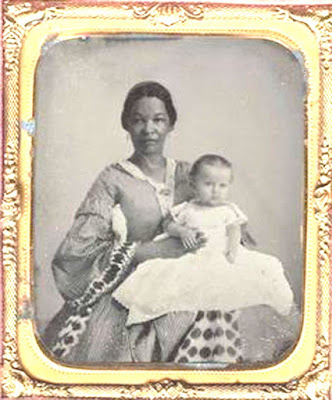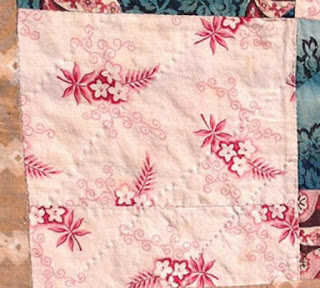Lucy Cottrell and her charge in Virginia, about 1845
Lucy's dress probably looked much
like this in color, a very showy Prussian blue stripe,
fashionable in the 1840s and '50s.
The daguerreotype of Lucy is in the collection of the Kentucky Gateway Museum Center. A slave whose duty is childcare, she holds her toddler charge in a common pose. Lucy is probably more a prop to keep the baby still enough to photograph than a person, an individual to be recorded and recalled by the people who paid for the photo. However, she is dressed for the photographer in a fashionable striped dress. It's so crisp it looks like cotton.
Or her dress might be a wool combination fabric as
in this dress from Tasha Tudor's collection.
Almost out of the picture, the woman seems to have a
nine patch quilt in her lap. We'd like to see more of the textiles---
and of course more about the women's lives. Showing some period
prints can bring the photos a little more to life.
Unknown woman in a checked apron and a striped floral dress.
Florals set in stripes
Most of these photos are from online auctions. I've
lightened them up to show the prints and the faces in the shadows.
Combination wool/silk weave---challis
Some women wear more formal wool and silk
street dress as in this carte-de-visite.
And older women often wear head scarves and something
like a uniform.
The uniform seems to become more standardized
after the war and emancipation when roles,
perhaps, were sharply defined in the new era of equality.
Many nannies of the 1840-1865 period are dressed in what may have been their
working wardrobe, at least when they were showing off the children, say to parents and
guests after supper.
Skinner auction.
Perhaps her best dress.
Document print for a repro in my Ladies Legacy
fabric collection for Moda, out soon.
Child care with flair.
This Philadelphia cabinet card looks like a post-war
photo but the dress print.....
with its wide stripes full of seaweedish vegetation...
Sleeves rolled up for work. Did that baby
just come out of the bathwater?
Short sleeves a practical solution.
Missouri Historical Society
Dresses one would wear to chase
after a toddler. Printed plaids or woven?
A printed plaid
Someone's hair saved in the metal case
Foulards (spotty figures in a diagonal repeat) were
quite popular during the Civil War years.
Polka dots are a form of foulard.
We can hope that pudgy baby is just sleeping
but from the look on the woman's face---a post-mortem portrait.
http://nationalhumanitiescenter.org/pds/maai/enslavement/text1/photosenslaved.pdf














































11 comments:
Thanks for continuing to enlighten us about this period in history. Obviously this type picture was pretty common among the wealthier folk.
What a wonderful photo gallery! I love the faces AND the fashions!
The photos are very touching. They make me feel intrigued and sad at the same time. I always wonder what were they thinking and feeling when I see pictures from this era. The second to last photo, the one perhaps "post mortem", looks to me like the lady has something wrong with her right eye. The sclera looks larger. Thank you for sharing these, food for thought.
The lady in the Philadelphia Cabinet photo appears to have 6 fingers on her left land. I found it odd the way her right hand rested atop the child's head. Interesting.
Very interesting. Do you suppose the dresses were borrowed for the photograph? Seems like fancy dresses for a slave but maybe they had one good one. Can you imagine washing and ironing these?
How very sad. Looking into their faces you can see the sadness and tragedy of enslavement.
I had to share this on Facebook with my quilting friends and my daughter. It's amazing to see the history of African American women who not only sewed their cloths but also the quilts they made while having to take care of their masters child! My hats off to them because I would of said a few words and they would of shot me!
The fabrics are very interesting. I’ve always wondered about civil war production prints, and where they came from. Some of the dresses are very pretty but no smiles from the children. I wonder if the children were shown affection from the women who raised them, and caring for children wouldn’t be such a bad thing, except when the children reached a certain aged the women, still being slaves, would be sold to another family. Would their nanny miss them going to another family? And how were those women treated while taking care of children, by their master and by the children? So many questions. Thank you Ms. Brackman. I look forward to your fabrics. I have already reserved them.
Judy, the photo graph was a new thing then, and took some time to develop/create the picture... the photographer would have to count to make sure it was fully "finished" and a smile was/ is a hard thing to hold still. That is why the old pictures all show no expression. Many had brackets to help hold the individuals head still during the process of exposure to light.
Judy, the photo graph was a new thing then, and took some time to develop/create the picture... the photographer would have to count to make sure it was fully "finished" and a smile was/ is a hard thing to hold still. That is why the old pictures all show no expression. Many had brackets to help hold the individuals head still during the process of exposure to light.
Those wild prints used for dresses are to die for!
Post a Comment